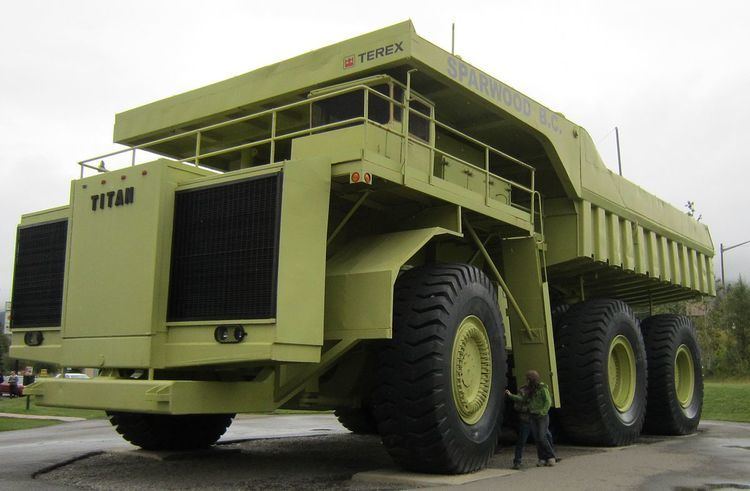Production 1973 (prototype) | Class Ultra | |
 | ||
Layout FR (Front-engine, rear-wheel drive) | ||
The Terex 33-19 "Titan" was a prototype off-highway, ultra class, rigid frame, three-axle, diesel/AC electric powertrain haul truck designed by the Terex Division of General Motors and assembled at General Motors Diesel Division's London, ON, Canada assembly plant in 1973. Only one 33-19 was ever produced and it was the largest, highest capacity haul truck in the world for 25 years. After 13 years in service, the 33-19 was restored and is now preserved on static display as a tourist attraction in Sparwood, BC, Canada.
Contents
Development and production
General Motors developed the Titan in response to the need for more efficient haul trucks by open pit mine operators. GM believed that a general decrease in mineral ore quality combined with a projected need to mine tar shale and tar sands would increase the quantity of ore hauled by surface mine operators' trucks, worldwide. The Titan was the largest in the Terex 33 series of off-road haul trucks, which also included the 33-03, 33-05, 33-07, 33-09, 33-11 and the 33-15. The 33-19 "Titan" and the 33-15 both used diesel/AC electric powertrains, while the other, smaller members of the 33 series of haul trucks used mechanical powertrains.
The Titan was assembled at the General Motors Diesel Division's assembly plant in London, Ontario, Canada, in 1973. The Titan was first shown to the public in October 1974 at the American Mining Congress in Las Vegas, NV.
GM predicted that when the Titan entered regular production, it would cost approximately US$1.5 million in 1976 dollars (approximately US$5.8 million in inflation-adjusted 2011 dollars). However, the Titan never entered regular production. The worldwide coal market softened in the late 1970s, causing coal mines to decrease production and economize by rebuilding existing equipment or purchasing smaller haul trucks with proven operational records. The projected market for the Titan never materialized and only a few were delivered to a Canadian miner. Several were still working in 2000.
Service history
Terex put the 33-19 "Titan" into service with Kaiser Steel at its iron mine at Eagle Mountain, California, in January 1975. The 33-19 "Titan" experienced frequent downtime, but over the course of its four years of service at the Eagle Mountain mine, the 33-19 "Titan" hauled approximately 3.5 million tons of earth.
In late 1978, the 33-19 "Titan" was sent to Kaiser Steel's mine at Sparwood, Canada. The mine was acquired from Kaiser Steel by B.C. Resources in 1980. When the mine was subsequently acquired by Westar Mining in 1983, the 33-19 "Titan" was repainted from its original Terex lime green livery to Westar Mining's blue and yellow livery. Shortly after, Westar Mining purchased the 33-19 "Titan" from General Motors for US$200,000 and $1 million of spare parts. During Westar Mining's ownership, the 33-19 "Titan" had an uptime rate of more than 70% and regularly hauled loads exceeding 350 short tons (320 t). Westar Mining retired the 33-19 "Titan" from service in 1991.
Public display
After acquiring the Sparwood Mine in late 1992, Teck Corporation offered the 33-19 "Titan" for preservation as a public monument in 1993. The Sparwood, British Columbia Chamber of Commerce completed a fund raising effort, restored the 33-19 "Titan", and promotes it as a tourist attraction. The 33-19 "Titan" is on static display off Highway 3 in Titan Park, 141 Aspen Drive, Sparwood, British Columbia, Canada. Although the 33-19 "Titan" was restored, the engine has been removed.
Specifications
The Titan has a payload capacity of 350 short tons (320 t), a net vehicle weight of 509,500 pounds (231,100 kg) and a gross vehicle weight of 1,209,500 pounds (548,600 kg). Fully loaded, the Titan had a top speed of 29.8 mph (48.0 km/h) At the time of its construction in 1973, the Titan was the largest, highest payload capacity truck ever built. The Titan remained the highest capacity haul truck in existence for 25 years until the début of the 360-short-ton (330 t) payload capacity Caterpillar 797 in September 1998.
The 33-19 Titan used a diesel/AC electric powertrain that consisted of an Electro-Motive Division model 16-645E4, 16-cylinder, gross 3,300 hp (2,461 kW), 10,320-cubic-inch (169.1 L), turbocharged, intercooled, unit injection, locomotive engine directly coupled to an Electro-Motive Division model AR10-D14, 10-pole, AC electric alternator sending DC power via a rectifier to General Motors model D79CF traction motors at each of the four paired rear wheels. The Titan utilized a power, all-wheel steering system. The front wheels swept through a 71-degree arc. At a preset point as the front wheels moved off-center, the eight rear wheels would also begin to steer, moving up to a maximum of 10 degrees off center. The Titan required ten 40.00x57 tires.
